Warning: This article will be heavy with statistics that’ll concern anyone who reads.
The staffing shortage isn’t just a threat to healthcare organizations. It threatens our entire society — from the bottom up.
There are many ways we can work together to combat this looming issue. However, we believe in taking a people-first approach to start solving this problem from within.
It’s common knowledge that the number of healthcare workers must significantly increase to meet demand in the coming years.
These shortage concerns are not new. For example, a study from a 2009 National Academy of Sciences workshop on the oncology workforce presented concerns about a shortage of nurses, physicians, and other allied healthcare professionals.
Although there’s no simple solution to this problem, we’ll explain how your healthcare organization can put your staff first during trying times. This way, you can improve employee happiness and reduce turnover.
In this article, you’ll learn:
- Why Is There a Shortage of Healthcare Workers?
- Healthcare Worker Shortage By the Numbers
- What Is the Impact of Staff Shortage in Healthcare?
- How a People First Strategy Can Empower Your Healthcare Staff
Why Is There a Shortage of Healthcare Workers?
Many reasons are causing the current shortage of healthcare workers. However, this problem has become exceptionally acute because of the aging population, including the Baby Boomer generation. Since people in the demographic require more medical care than the general population, it’s causing a shortage of physician specialists and nurse practitioners.
Additionally, advances in medicine and medical technology have enabled people to live longer. This means people are more able to manage chronic conditions as they age, so those who reach retirement age will still need healthcare for a more extended time period than previous generations.
To worsen the situation, the healthcare sector was undoubtedly unprepared when the COVID-19 pandemic soared across the world, taxing healthcare organizations that were already short of crucial frontline workers. Although the global pandemic exacerbated the issues, structural problems such as poor retention and a lack of long-term workforce planning pre-date it.
The director of policy at the American Hospital Association trade group claims that the “workforce in healthcare is an issue of national significance and is reaching a crisis in many parts of the country.”
Additionally, the healthcare shortage has become so grim that at least 20 governors this year directly addressed the situation in their state of the state speeches. These governors proposed a range of policy fixes.
This includes boosting recruitment efforts, expanding training programs, loosening licensing requirements, and raising providers’ pay, either directly or by increasing Medicaid reimbursements.
The healthcare worker shortage has also been exacerbated by years of systematic underfunding in healthcare, causing millions of nurses to quit. While the United States is estimated to spend $3.6 trillion annually on health, less than 3% is directed toward public health and prevention.
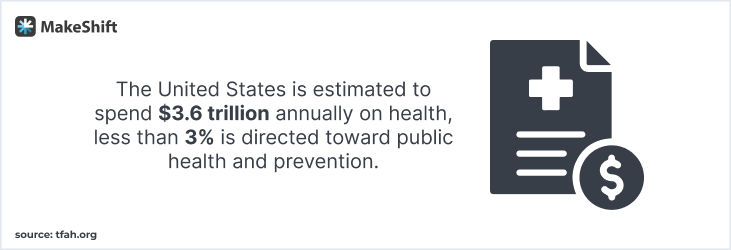
In addition, public health spending as a proportion of total health spending has been decreasing since 2000 and decreasing in inflation-adjusted terms. Therefore, healthcare organizations across the country are battling 21st-century health issues with 20th-century resources.
Without proper funding and fair pair, it’ll be difficult for healthcare clinics to recruit, train, and retain the correct number of staff they need to treat their patients properly.
Healthcare Worker Shortage By the Numbers
To paint a picture of how drastic the healthcare shortage is, it’s important to look at statistics. So, let’s discuss a few key numbers about healthcare worker shortages you should know about.
A study from Mercer found that the US would face dramatic healthcare worker shortages in the next decade.
Mercer predicts that by 2025, there’ll be a shortage of more than 400,000 home health aides and 29,400 nurse practitioners.
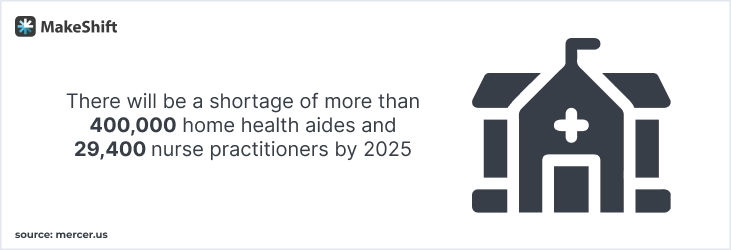
There’ll also be shortages in nearly every other healthcare profession.
By 2030, the World Health Organization (WHO) predicts a worldwide healthcare shortage of about 18 million healthcare workers.
%20predicts%20a%20worldwide%20healthcare%20shortage%20of%20about%2018%20million%20healthcare%20workers.png?width=731&height=251&name=By%202030%2c%20the%20World%20Health%20Organization%20(WHO)%20predicts%20a%20worldwide%20healthcare%20shortage%20of%20about%2018%20million%20healthcare%20workers.png)
This poses deadly consequences for patients, economies, and communities across the globe.
The American Association of Colleges of Nursing (AACN) suggests that the United States will need more than 200,000 new nurses annually until 2026 to replace retiring nurses or fill new positions.
Although enrollment in nursing programs is rising, it’s not sufficient to meet demand. This problem of nurse shortages is especially prevalent in areas such as education and for certified family nurse practitioners who can provide primary care without a doctor’s direct supervision.
Making it worse — Mercer estimates that around 9.7 million people currently work in low-paying healthcare jobs, such as home health aides. So while the need for home health aides will continue to rise for the next half-decade, there won’t be enough replacements to fill the spots people leave when they retire or change professions.
At the current rate, 6.5 million workers will leave during the next five years, and only 2 million will fill their spots. In the same frame, the number of physicians of retirement age will grow from the current 12% rate to 21%. In addition, the United States may face shortages of 37,800 to 124,000 physicians by 2034, according to a report from the Association of American Medical Colleges (AAMC).
This report also identified that the over-65 population will grow by 48% by 2032. Sadly, many working physicians, along with the other Baby Boomers, will reach the retirement age by this year.
This is a detrimental problem because of how difficult it is to become a healthcare worker. Healthcare workers require extensive training and specific qualifications. So, why would people choose to become healthcare workers when they’re subject to challenging work schedules and underwhelming pay?
The Mercer report also indicates that 29 states will be unable to keep up with the demand for registered nurses in the next five years, as 900,000 are predicted to leave their positions permanently.
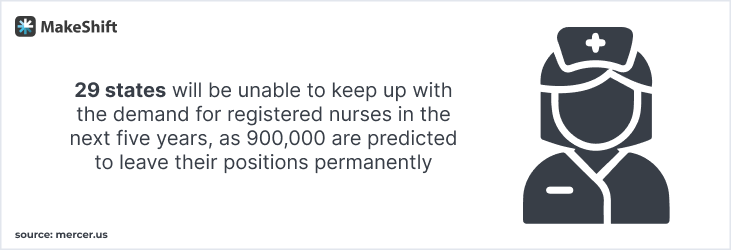
Furthermore, the United States will also be impacted by a shortage of mental health workers, as demand will increase by 10% by 2026 while 400,000 professionals will leave their positions for good.
The COVID-19 pandemic also caused 80,000 to 180,000 healthcare workers to perish from the virus between January 2020 and May 2021. This made the healthcare shortage across the world even more difficult to deal with.
And to top off this series of unfortunate events, 20% of healthcare workers in the United States have quit their jobs since the pandemic’s start.
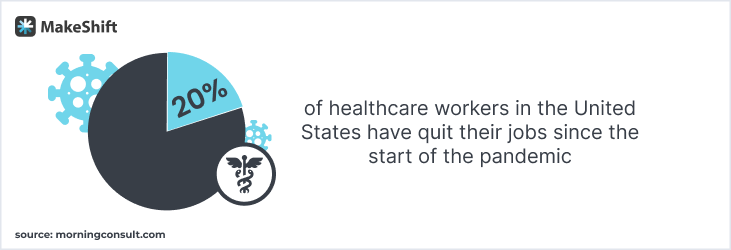
This left gaps in most healthcare organizations and caused even more stress and burnout among workers who stayed throughout the pandemic.
What Is the Impact of Staff Shortages in Healthcare?
The impacts of staff shortages in healthcare are felt throughout the sector. However, burnout and exhaustion are the two primary effects of employee shortages.
While healthcare is already an intensive profession, burnout and exhaustion took an enormous toll on the healthcare workforce during the COVID-19 pandemic. As mentioned earlier, 1 out of 5 healthcare workers quit their jobs during the pandemic. And a third of the remaining staff acknowledges that they’ve thought about quitting.
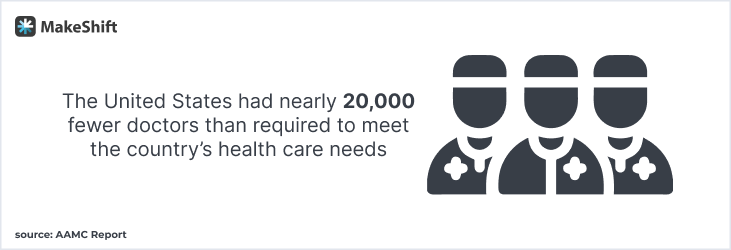
However, these problems didn’t start with the pandemic and won’t end with it. According to the AAMC report, the United States had nearly 20,000 fewer doctors than required to meet the country’s health care needs in 2019.
Clinician burnout and staff shortages are linked and are listed as the biggest threats to patient safety in the United States. Staffing shortages lead to longer patient wait times, even in life-threatening emergencies with potentially fatal outcomes.
A study indicates that burnout, specifically emotional exhaustion, is associated with worsened patient quality and safety of care. In addition, the study finds nurses and patients negatively rate the care provided when nurses are burnt out. This includes other adverse outcomes, such as medication errors, patient falls, increased infections, and increased mortality.
Burnout also has implications for the entire workforce. Healthcare staff who are burnt out may reduce their shifts, quit their jobs, or retire early. These staff reductions contribute even more to workforce shortages, meaning fewer employees are available to care for patients. It also leads to increased pressure on the clinicians who stay to perform.
In essence, staff shortages in healthcare lead to:
- Employee exhaustion and burnout
- Patient risk
- Inefficient schedules
- Overtime and back-to-back shifts
- Negatively impacted organizational bottom line
These factors also lead to moral injury among your workforce. Moral injury is the psychological, spiritual, and social impact of events which a person who holds strong values and operates in high-stakes situations.
Since a burnt-out worker still needs to tend to their patients, they can have strong feelings of shame and guilt since they cannot uphold their healthcare values. They may also feel high levels of contempt and anger towards the healthcare system that prevents proper care.
How to Use a People-First Strategy to Empower Your Healthcare Staff
While you may understand how the impact of healthcare staff shortages affects your organization, it’s crucial to do something to solve it.
So, let’s discuss how your healthcare organization can help recruit and retain healthcare workers and support their mental health during these difficult times we face.
Your goal should be to enable your staff and give them everything they need to look after their patients properly.
Recruit and Retain Medical Staff
Recruiting medical staff is essential — but even more — is being able to retain your staff long-term. Because it won’t matter how many employees you hire if your organization is a revolving door with staff coming and going.
You should increase policy initiatives to support your organization’s human resource development programs. This includes offering more training and resources to your entire organization. Your staff wants to add as much value as they can, but they can’t achieve this goal without the proper support.
You can also give your healthcare workers a voice in shaping legislation and policies. Healthcare workers are the most qualified people to make decisions on how to better your organization since they’re on the front lines day in and day out.
In terms of your hiring, make sure you recruit the right people — avoid hiring someone just to fill a vacancy. The people you hire should hold the same values as your organization and have an attitude and personality your patients and colleagues will appreciate.
In today’s competitive hiring market, you also have to work towards providing more competitive benefits. This could be through:
- Higher pay, especially for hard-to-fill shifts
- Flexible schedules
- Paid time off
- Health insurance
- Retirement plans
When in doubt — don’t guess — survey your staff so you can offer them what they want to keep them satisfied.
Manage the Effects of Healthcare Worker Shortage
You can also implement scheduling systems that manage the effects of your healthcare organization’s staff shortage. For example, you should let your staff set their preferred availability.
Letting your staff set their preferred availability gives them autonomy over their career. This will help you prevent burnout, exhaustion, and stress while also reducing overtime shifts and turnover.
You should also let your staff swap shifts easily. For instance, if a nurse has a sudden emergency and can’t make it to work, they should be able to trade their upcoming shift with another employee who’s willing to swap. This way, your staff can act independently amongst themselves to solve scheduling crises.
Another important scheduling guideline is to make schedules well in advance. This way, your staff can request changes and adequately plan for their future shifts. While making your staff schedules, it’s also essential to avoid overtime and back-to-back shifts. Worker fatigue causes impaired patient care, and you must let your staff get proper rest.
Fortunately, healthcare staff scheduling software, like MakeShift, implements the abovementioned solutions. Therefore, optimal scheduling is the best way to run an efficient healthcare clinic. This way, your employees can perform to the best of their abilities to provide outstanding patient care.
Ready to Make the Shift?




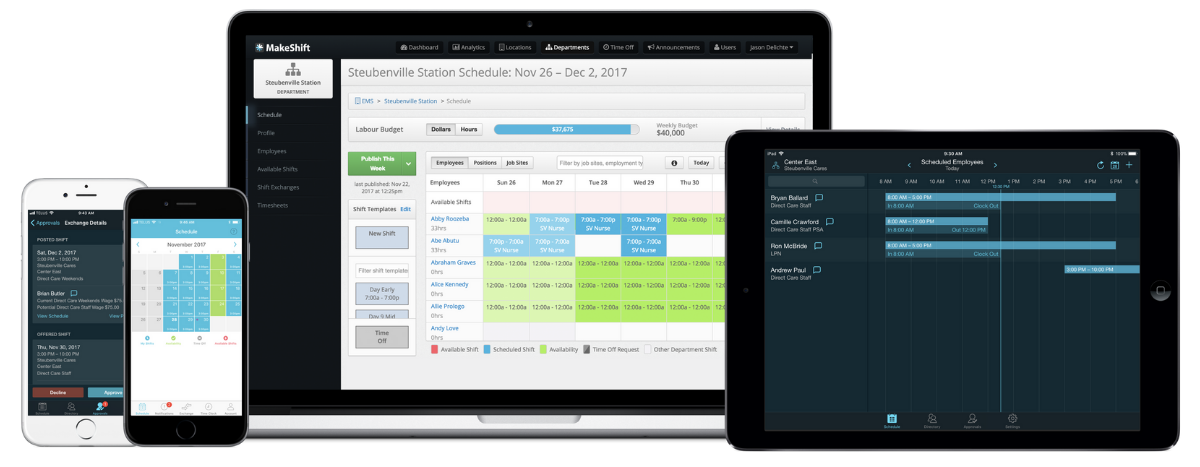



.jpeg)